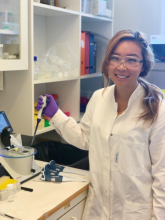
University:
Major:
Site Abroad:
Mentor(s):
Faculty Sponsor(s):
Faculty Sponsor's Department:
Project Title:
Project Description:
Formaldehyde can be produced by coupling two enzymes, formate dehydrogenase (FateDH) for the conversion of CO2 to formate and formaldehyde dehydrogenase (FaldDH) that reduces formate to formaldehyde. These enzymes use the cofactor nicotinamide adenine dinucleotide (NADH) as the terminal electron donor. The concentrations of the formaldehyde produced were measured using a Nanodrop One Instrument from Thermo Scientific. To improve the biocatalytical activity of the enzymes they are usually immobilized through physical adsorption in mesoporous materials such mesocellular foams (MCF). Zeolites are materials which are typically used in catalysis and in capture of CO2, however their microporosity cannot be used in the immobilization process due to the ultrasmall pore size. Therefore, we have developed mesoporous zeolites that contain both microporosity and mesoporosity (around 30 nm) which are proved by using BET Theory and imaged by TEM. Thus, the enzymes are successfully immobilized in these mesoporous zeolites, so that the efficiency of formaldehyde production could be improved by using CO2 capture ability of zeolites. Hence, different reaction strategies are implemented so that the catalytical activity can be tuned.
